Video Recap: Klondike Highway, Keno Hill and Mount Hinton
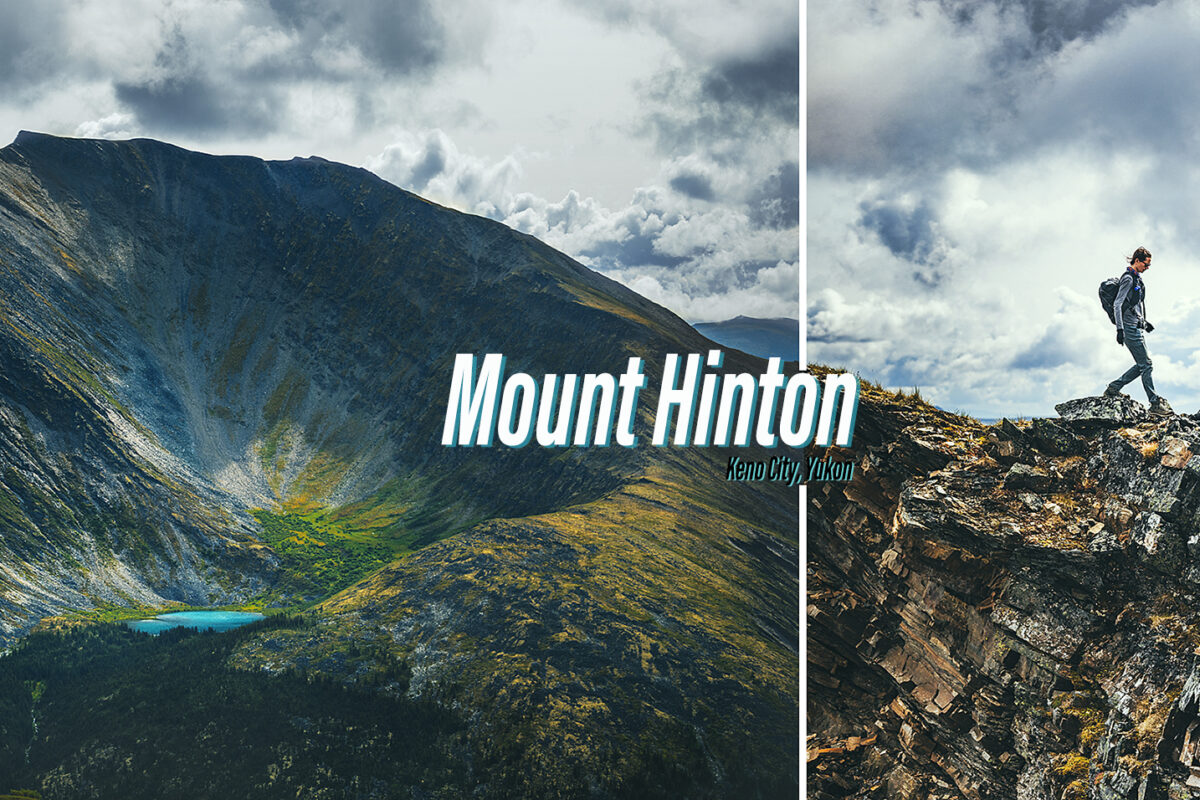
Our adventures around the world…

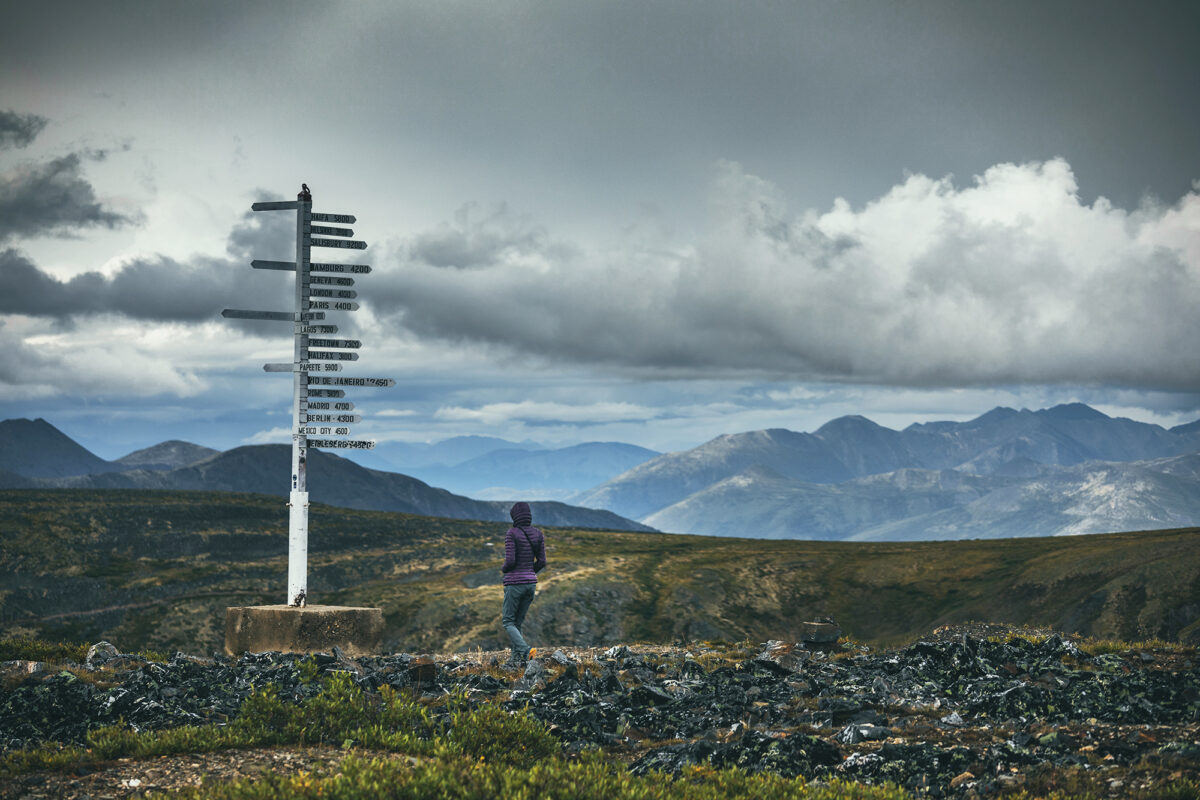
It rained pretty heavily in the early morning so we took some time getting up.
Brice made pancakes – more successfully than the last time. We had put the tarp on the bug shelter this time, instead of the sleeping tent, so the table was nice and dry for breakfast. Then we started packing things up, which was a bit of a process with everything being wet and untie-ing all the ropes we set up for the tarp. Eventually we took off and drove to Pelly Crossing, where we stopped for a bit to do some internet-ing (emails, instagram…) as there was phone service there.
Then we were on our way. In Stewart crossing further down the road, we turned right to head East on the Silver trail, (Highway 11) for our second side trip – to Mayo then Keno City.
We stopped at a rest area for a quick lunch, and managed to get the tents and tarp 90% dry in the time we ate, thanks to a bit of sun and wind (with all the rain, we frequently took advantage on any dry spell during a stop to hang the tents out to dry).
The stop had a nice view of the Stewart River, which was heavily mined for gold during the Klondike gold rush era, but it also turned out to be extremely rich in Silver (hence the name Silver trail), making it one of the top silver mining areas in North America until it closed in the late 80’s.
We followed the river all the way to Mayo, which is located on the traditional territory of the Na-Cho Nyak Dun First Nation, who have lived there for thousands of years.
Once there, we went for a visit of the Binet House, a restored heritage building with a display of photos and artifacts, showing daily life in the small mining community that occupied the town in the late 19th and early 20th century. There was also as a small section about the geological characteristics of the area. All and all a pretty in-depth view of the mining era, and our first dive into that history, after following the roads that were built to make the mining possible.
Both towns of Mayo & Keno were bustling with community life through the 20th century. Nowadays there are less than 500 souls in Mayo, most of which are First Nation born in the area. Keno, further down the road, has a population of 20!
After the visit, it was still early in the day, so we decided to drive to Keno for the night. The way there was quite scenic, as we climbed the unpaved road surrounded by mountain ranges. The scenery up until that point had been mostly rolling hills with trees, ponds and lakes as far as the eye could see.
We arrived in the tiny town and drove to the small campground located down a short dirt road. We were the only ones there at that point. We set up camp and had a snack, and as it was starting to rain, we decided to drive up to Keno Hill, a viewpoint at 1800 meters accessible by car (4WD recommended).
That was the best decision! The road there was incredibly scenic, revealing a different mountain range at every turn, and the sky was unreal. Blue with fluffy clouds on one side, dark and hazy, with rain curtains on the other. All the conditions were right to get a rainbow, which we did.
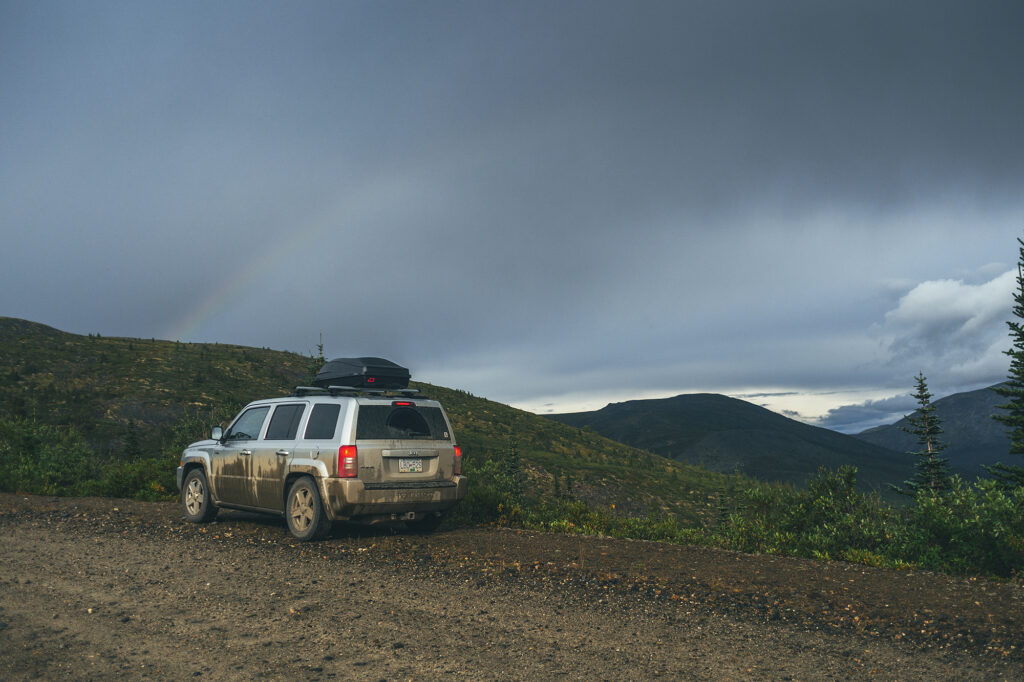
We reached the signpost at the end of the road, a couple of km from the summit, and the views were remarkable. The valley laid below under the dark stormy clouds, a sliver of golden light filtering through along the peaks in the distance – and still some blue sky over peaks in the opposite direction.
The sign post itself was erected for a geological convention of sort some years ago, and the various signs point to the cities around the world where the scientists attending the event came from.
Past the sign post, the trail keeps going to a higher hill, easy to see as the alpine vegetation is all low shrubs. I decided to venture up there on foot while Brice flew the drone up. The summit seen from below was actually a false summit, as I found out when I reached it. The second (presumably true) summit was still some ways away still so I decided to turn around. I still got some really great views from the false summit and I enjoyed running down the wide, rocky track on the way back down.
Once I got back to the car we drove back down to the campground for dinner. It was the first time in a few days that bugs weren’t all over us, and it didn’t rain, so we were able to sit by the fire and enjoy the evening outside the bug shelter.
As a side note, there was a group at the top of Keno Hill when we got there, and sure enough, it was a bunch of French people (Some from France, some from Canada, based on accents). Of course we found them back at the Campground (there is only one) – As we’ve often found in our various travels, no matter where we go in the world, how remote we get, we always seem to run into the French.
I wonder if other nationalities experience that as well and maybe we only notice French people because of the language…In any case it’s become a bit of a joke, and we can sometimes even identify French people just by looking at them…
We decided to stay one more night in Keno, so we could take time to do a local hike.
After breakfast we drove to the Mount Hinton trailhead. The directions from Alltrails were actually incorrect and took us down some random mining roads. We eventually found the correct directions, which basically consist of driving up the Sourdough trail, to the top of Sourdough hill, and then continue down into the next valley to a creek crossing. At that point, the road gets quite steep and rocky that’s where we started the hike.
The hike follows a wide dirt path along the side of the mountain for a bit, with open views all around since the vegetation is quite low.
On route we passed two RTVs and for once I thought this could have been a better way to get up the trail.
The trail is really the equivalent of a forest logging road, except in the area it would have been carved out for mining. After a few km of circumventing, we reached a split with one trail to the left going straight up to the ridge, while the other to the right seemed to go down.
So we climbed to the left and reached the ridge for a pretty stunning view. Looking back at the Alltrails GPS later, I think we might have gone a bit further on the road and missed an earlier fork to climb to the summit, but we still got really great views.
When we made our way down, we noticed an excavator next to the two RTVs seen on the way up. It was digging a trench into the side of the mountain. We stopped to ask one of the workers who was standing by the vehicles and he explained they were testing the ground for potential gold mining. The excavator was going to dig out a 100-meter trench followed by a 3m hole and they would assess the ground, to potentially come back next year to start mining.
For some reason, I naively thought gold mining was a thing of the past and didn’t expect to see active digging. But it’s very much still alive, and there are apparently reality TV shows about it shot in the area. I wonder what it means for this hike and the surrounding landscape if the area becomes a mining site next year…
Back in town, we took a tour of the a local museum, which gives a very good overview of the beginning of mining, tools used, a bit about geology, the living conditions in the small mining community in the first half of the 20th Century.
Outside of the main building, two other large buildings housed old machines and vehicles used back in the day – examples of intricate engineering that go right over my head but still very interesting to learn about – and marvel at the technology that was developed progressively to facilitate the work.
We were able to have a shower at the community facilities, for a small fee paid at the Museum front desk. We went back to camp for dinner then decided to go grab a beer at the local bar – the only commercial building still active it seems. Other services previously included The Snack bar, famous for its pizza, but it was presumably only open for take-out, and the former hotel across the street from the bar, which had burned down in Dec 2020 (and one would almost say a bit suspiciously, based on chatting with a couple of locals).
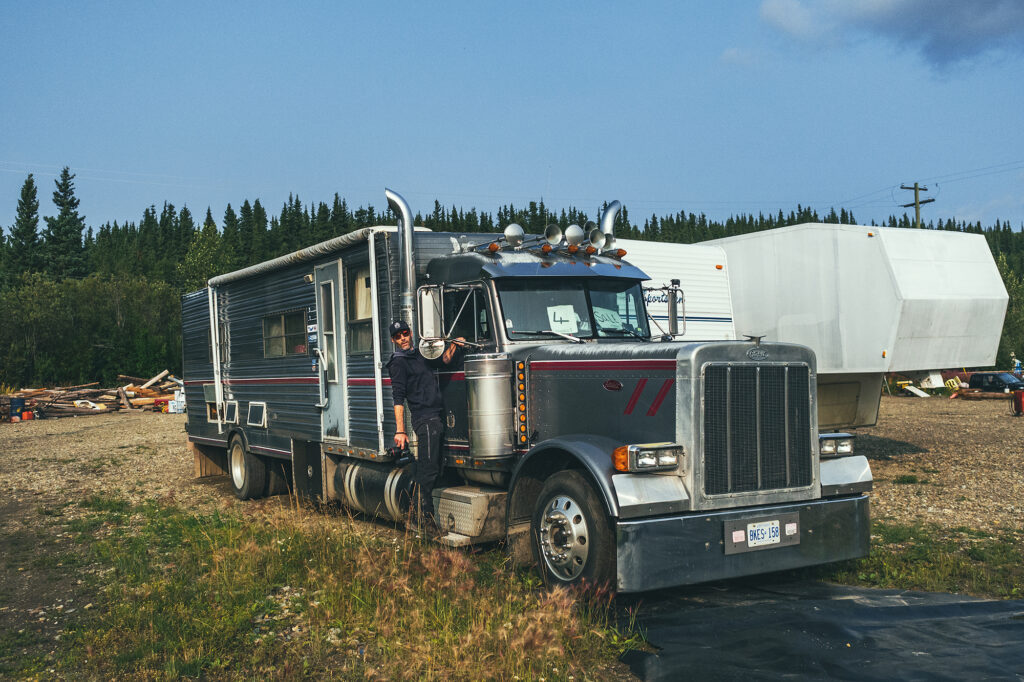
We hung out on the bar porch while listening to local patrons chat (that’s how we learned about Gold Rush and other reality TV shows going on at active mining camps nearby). Eventually we came back to the tent for a good night sleep.
We drove a good portion of the day from Keno to Dawson city. There wasn’t too much to see on the way, and the drive was made a bit longer by all the construction zones and having to wait for pilot cars to go through them (we had at least 3). The road near Dawson changes from paved to gravel which slowed us down as well.
We arrived around 3pm and after doing some small gear purchases and doing a reset for our upcoming trek in Tombstone Territorial Park, we headed out for a dinner.
We had a very comfortable night in a cushy bed before our 6 am wake up the next day to drive to Tombstone.
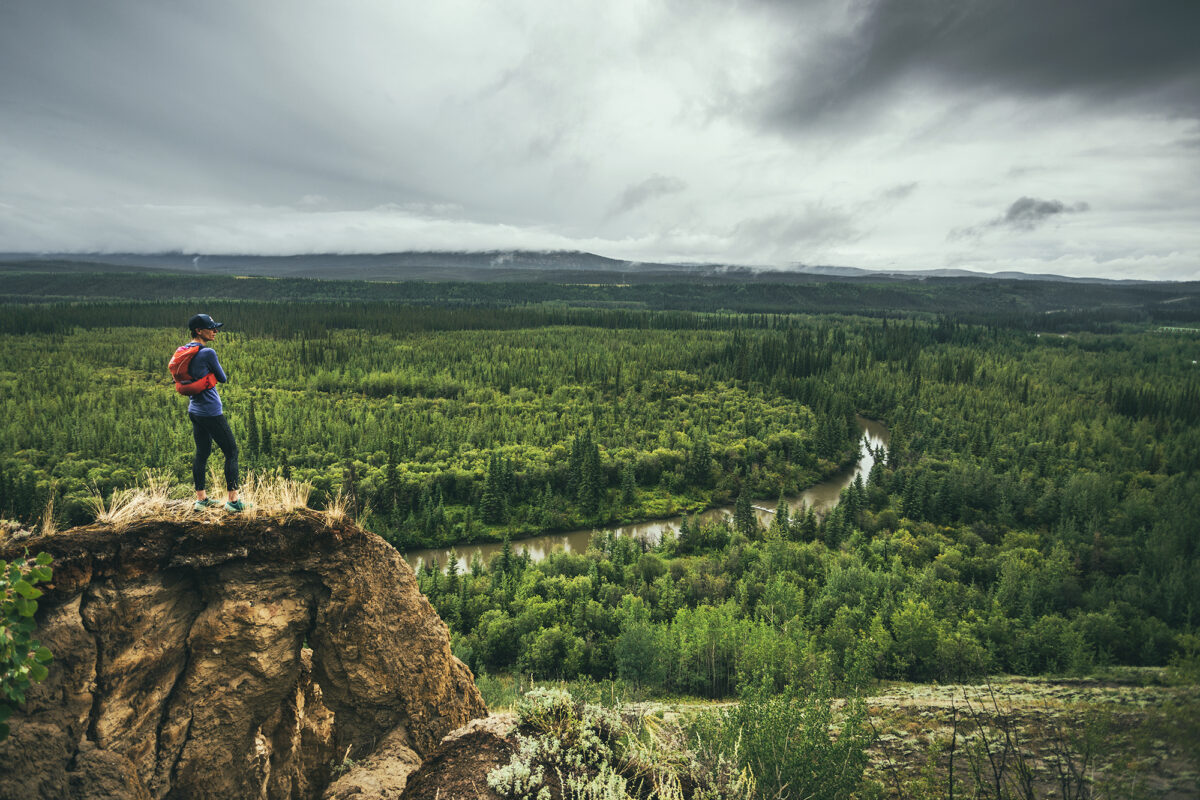
In Watson lake we had our first experience of the Government campgrounds, which are peppered all over the Yukon. They only cost $12 a night, for a site with picnic table and firepit, and wood is provided for free. No amenities, but as we found out through our various stays, the outhouses were always remarkably clean and well stocked up in TP. Overall we never had a bad experience at one of those campgrounds, and we always knew more or less what to expect, as the set up was pretty consistent.
Brice made pancakes for breakfast (or tried to, they didn’t quite turn out how he normally does them). Then we left our camp. We stopped at the Sign Post Forest, which displays signs (or license plates) made by people who visited.
It was started in the 1940’s by a GI who was feeling homesick and was trying to make something that reminded him of home. It evidently became a thing that people do when coming through the town. Apparently there are now over 80 000 signs! I guess it’s the local equivalent of the bridge of locks in Paris – except there’s no danger of the forest of posts collapsing under the weight of the signs…it seems it could still expend for a bit.
We then headed off and spent a few hours driving, making only one stop in Teslin (about halfway between Watson Lake and Whitehorse). We visited the Teslin Tlingit Heritage Center, which has a small display of Tlingit artefacts – small but impressive, with beautiful beaded garments and carved masks by local artists.
We watched a 15 min documentary about the celebrations the Tlingit people organize when their relatives from Juneau, AK come to visit.
The Tlingit people originated from Coastal Southern Alaska, but some migrated inland for fur trading, and as craftsmanship evolved they were able to spend more time in the cold interior winter, eventually settling away from the coast. The descendant of the migrants refer to themselves as the Inland Tlingit, but still have a very strong bond to their coastal cousins, which they celebrate with regular potlatches.
For a period of time though, these gatherings were restricted by the ban on potlatches, which was in place between the mid 1880’s and the 1950’s both in Canada and the US.
The celebrations take place in and around the heritage Center, which also serves as a meeting place. Normally open to visitors, they haven’t been in the recent 1.5 years due to Covid.
We also stopped by the George Johnston museum, but it was closed that day so we made a note to try and stop again when we drive back a few weeks later.
Our next stop was in Johnson’s crossing, after Brice spotted a bakery sign on the side of the road, and we had a couple of pastries for afternoon snack.
Eventually we arrived in Whitehorse and this will come as no surprise to anyone who knows Brice, our very first stop was at a Car-wash to rinse off all the dirt and mud collected along the way.
We had booked another Airbnb for that night. This time we had found a private Bed + Bath in a private house. The set-up was clean and comfortable, but the hosts were not super welcoming, barely saying hi when we got in. Mind you, the previous hosts in Old Hazelton hadn’t been super warm either, so it’s likely Covid had something to do with it. We hadn’t been in an Airbnb since before the pandemic, and our last experience before that was a 10-day stay in a private room in Austin, Tx, where we got to meet and interact with our hosts on a daily basis. But of course the pandemic would have had a huge impact on how much interaction hosts are trying to have (or not to have) with their guests.
We put our stuff down and headed out for dinner, taking advantage of being in a city to go to a proper restaurant. It was almost a bit strange to be sleeping inside a house, after all the camping, but still nice to be able to shower and sleep under a roof, and not have to set up and take down camp.
As we arrived in Whitehorse, I was checking the forecast, and it looked like a lot of rainy days ahead in the Kluane area, which is where we had planned on heading to next. I didn’t really feel like hiking in the rain and missing out on scenery covered in clouds, so we decided to head out to Dawson City early. But instead of driving there in one day, we would take the long way up and spend 3 days doing side trips to Faro & Keno, places that weren’t originally on the itinerary. In turn, we would go to Kluane after coming back from Dawson City, hoping that we would have better luck with the weather then. It also meant trading the Carcross Tagish/Aitlin loop we had also intended later on for this plan but so it goes. At least we had enough buffer time on this trip to be able to make these adjustments, as we didn’t have a set return date in Vancouver. And as we’ve learned on other trips, it’s always good to have a set itinerary, but be prepared to adjust it on the fly.
In the morning, we took advantage of the city to take care of a few errands, such as getting more cash for the campgrounds, and restocking on groceries. Then we stopped at Alpine Bakery on the way out, to enjoy a couple of sweet pastries in their cute garden patio, and grab some savory treats for lunch later. Then we got on the road, headed North on the Klondike Highway.
We made our first stop at the Fox lake Burn rest area, and walked down the short interpretive trail that leads to a ridge and provides information on forest fires. It described their impact on the ecosystem and how they can be beneficial in the natural cycle of things, allowing new plant and animal species to repopulate an area after a fire. A lot of the naturally caused fires (usually lightening) happen in more remote areas, and they are often monitored but not intervened on. Man-caused fires on the other hand tend to happen closer to populated area and of course cause bigger problems, as they impact human infrastructures and lives. And global warming is making it easier for fires to spread, with vegetation being a lot drier and the lack of rain to control them.
The ridge was incredibly windy! It reminded me of Patagonia, and the types of wind we encountered there, sometimes able to knock you off your feet. I could see how fire would propagate at incredible speed with winds of the sort.
Our next stop was at the Braeburn Lodge. We came up to it just as I was reading in the Milepost that “their cinnamon rolls can feed 4 people”. Clearly we had to stop and check for ourselves.
Sure enough, the buns where the size of a small cake. It was lunch time though, so we decided against buying one (also, they were REALLY big and as much as I like pastry, that was a bit too much for me), and instead went for a grilled cheese sandwich – which by the way could also have fed 4 people. It was super simple but very tasty.
Our last stop on the Klondike that day was at the Montague Roadhouse Historic Site. Until the beginning of the 20th century, the Klondike river was the main way of transportation between Whitehorse and Dawson City. Then in the early 1900’s, the Overland Trail (now Klondike highway) was built to connect the two towns by horse and carriage. The Montague Roadhouse is the only remaining trace of the pioneer-era rest stop along the trail. Rest stops of the sort, with overnight accommodation, were found every 40 km or so along the trail. You can still see some of the main roadhouse building at the site, and read about the history of it.
Once we got to Carmacks, we left the Klondike Highway for our first side trip, heading East to Faro on the Campbell Highway.
We set up camp at the John Connolly municipal park, a nice campground with hot showers (always a plus). We were quite tired from the long drive but decided to take the short hike along the Van Gorder waterfall trail to stretch our legs.
Mosquitos were, once again, a bit aggressive (we wore our bug jackets to the waterfall!), and it rained for a good portion of the night, but we still had a cozy sleep in our little tent.
The next morning we decided to go for a trail run before heading back out.
There’s a network of trails around Faro, which don’t actually seem to exist on google map, but I picked up a good old paper map from the visitor center across from the campground (they also have a pdf version here). Aside from the overall scale reference, there’s no indication of length, elevation, etc. but it did look like we could do a roughly 10km loop around the town, starting right at the campsite so that’s what we set off for. The trails all have animal names and signs at some intersections but it did take a bit of navigating with the map to stay on our intended route. The trails were not very technical, albeit pretty muddy, but we encountered a few decent hills – and we did get couple of nice views from above the town. As suggested by the map, these trails are likely more used in the winter for cross-country skiing and snowmobiles.
Mosquitos weren’t as bad when we were running, and we managed to stay mostly dry aside from the 93% humidity in the air. After the run, we enjoyed the hot showers then had our savory pastries from the day before for lunch. We ate them on the patio of the information center, which was looked after by the most lovely lady, who offered us free coffee. We then headed back to Carmacks, to continue our journey up the Klondike highway.
The campground in Carmacks sounded good on paper – offering waterfront campsites and burger joint, but when we got there it didn’t turn out to be that exciting – a messy-looking stretch of ground near the river, only separated from the main road by the parking lot, and the pub didn’t look very inviting. It was also quite busy, which was a third reason for us to continue on, to try and find a quieter, more appealing campsite for the night.
We continued North and landed at the Tatchun lake Government Campground, located a few km down a dirt road – away from the highway traffic noise. Note that there is a Tatchun Creek campground up the road, but that one is also near the road, exposed to traffic noise.
For the first time in our trip it felt like the mosquitos were less intense, probably because temperatures were starting to lower. We set up camp a bit earlier than other days, so we had time to relax in the evening, work on photos, write our travel journal, and enjoy some time by the fire.
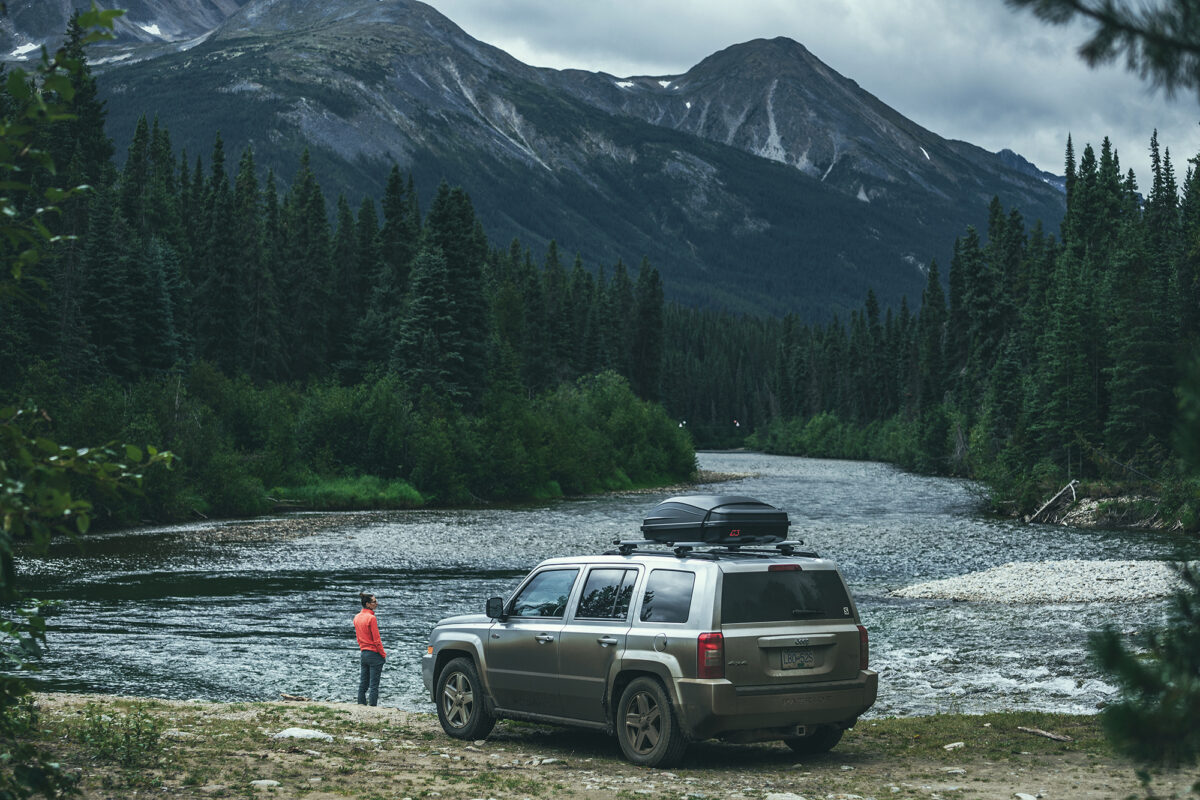
On our last morning in Stewart, we grabbed pastries at Temptations bakery (raided it, really more like) and had a couple for breakfast in the park area off Main st. Then we got back on the road, driving back East to Meziadin junction, before heading north again on highway 37, also known as the Stewart-Cassiar Highway.
The road was pretty unremarkable at first, except for 1 grizzly bear we saw right off the side of the road.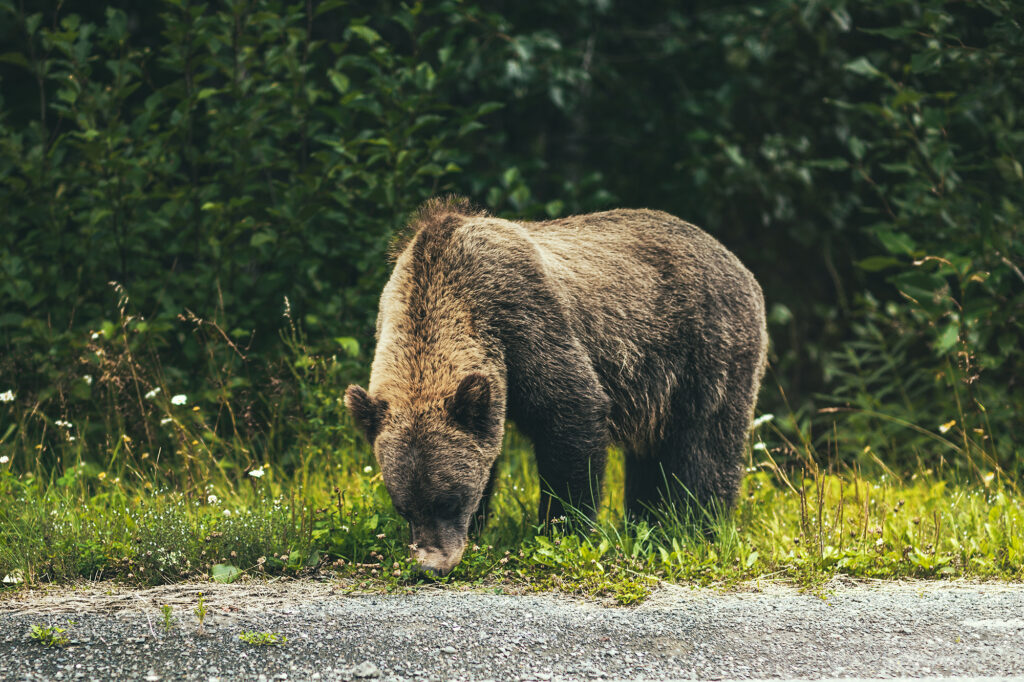
After the Ningunsaw pass, we stopped at Bob Quinn Lake for lunch.
We started seeing bigger mountains on either side of the road, although a lot were covered in clouds. I was actually a bit bummed out by the weather, as I had hoped we could take the kayaks out for a nice paddle at one of the many lakes we passed, but the cloudy, windy and low temp weather didn’t feel very conducive to a water adventure.
I had also looked at the forecast for Whitehorse and Dawson city and it looked like a whole lot of rain coming up, which I wasn’t so thrilled about. But I guess it’s better to go expecting poor weather and be glad if/when the sun comes out, than the other way around? We had been warned by our friend Adele, who had done a similar trip a few years back, that they had gotten a lot of rain, so I was somewhat prepared for it, but still a bit annoyed when it turned out to be a daily occurrence.
I should note that this whole section of road is quite isolated, with little to no cell service and very few places to stop for gas (but not far enough apart that you would need to carry an extra container of fuel).
The one bit of excitement that day came when we decided to drive down a dirt road to see where it would lead (we didn’t have any indication that it would lead to anywhere particular, but sometimes you end up in a cool scenery by taking a random side road).
After driving 10 or 15 minutes down the path, we got to a bridge over a river and Brice asked me to drive over it while he was getting some drone footage. He got in the car with me and we crossed, but hit a fairly big drop upon touching the other side, car bumper hitting the ground heavily.
I turned the car around and we went to look at the drop. It was actually a pretty significant hole, at least 2 feet wide and 5 feet deep, across 3/4 of the width of the bridge, leaving only about 2 feet of connection between the bridge and the ground. No idea how I even managed to drive through it in the first place. It’s possible the hole was a bit smaller and a bunch of dirt fell off under the weight of the car. We tried driving back through, as close to the connected side as possible, but the right front wheel would dip into the hole and spin, unable to find traction, with the bumper resting on the edge of the bridge. For a moment I was slightly concerned that we found ourselves stranded down this random road with no cell reception, but we quickly started looking around and figured we could build a makeshift platform to connect the gap.
Thankfully we had all the equipment needed in the car, and lots of fallen branches around to chop up and strap into a small bridge, which the car was able to drive over. While I was pretty relieved to see the car back on the other side, Brice says he was never worried as we had everything with us to figure out a solution. Takeaway from this: always check the full condition of the bridge, before driving across it.
After the bridge mishap and getting back on the main road, we made another bit of rookie mistake a bit later on (seems like it was the day for it).
On the map I had seen a short trail leading to a lake. We got to a spot in the road near where the trailhead should be, and actually saw people returning from the trail, so we started walking down it without even checking for a sign or anything (which is VERY unlike me).
As we walked down, the trail kept going and we realized:
After that realization, and walking down another 15min without seeing the end of the trail, we just turned around and walked back with lots of loud singing and noise making. Turns out it wasn’t even the right trailhead to access that lake, the correct one was a bit further, and a few kilometers out and back, so we decided to skip it and go to a lake we could drive to instead.
We also had had our quota of lake for the day, having stopped at Bob Quinn lake for lunch, a rec site with dispersed camping, and at the Eldontenajon lake rest area (the lower area right by the lake) for a snack later. There was definitely no shortage of lakes off the side of the road.
I had pinpointed Tatogga as our place to stop for the night but we ended up driving just a bit further. We set up camp at Morchuea lake Rec Site, a pretty scenic lake with views of Mount Edziza, but probably the highest concentration of mosquitoes we’d seen so far. For the first time on the trip we made use of our bug jackets, pretty invaluable to keep calm when trying to set up camp in a swarm of hungry mosquitoes. And thankfully the net shelter did a good job at keeping them out as well, and ensuring a relaxing evening.
As a side note, Mount Edziza wasn’t on the list for this trip as there is no road access, and it would be a whole other trip to plan on its own. But our friends Adele and Thierry’s trip from a couple of years ago certainly made us want to put it on the list for the future.
Given the poor conditions at the Morchuea lake Rec Site (mainly the fierce mosquitos), we had packed most things into the car the night before, as we knew we wouldn’t stick around for breakfast.
It rained quite a bit that night but it stopped by the time we got up. We had put the tarp over the tent for the rain but also to create a vestibule preventing mosquitos to come in, which prove pretty effective (our tent does come with an extra vestibule that you can zip on, but we’d only ever used it once, found it a bit cumbersome, and didn’t think to bring it on this trip).
We left camp and drove to the closest gas station for a refuel and coffee..
Then we drove to Dease Lake. BRMP indicated a hot spring nearby but at that scale, the map was a bit vague and didn’t describe a clear access point. We looked for it in the forest along the stream but couldn’t find it. If it existed, it definitely wasn’t one that was advertised by the locals.
We picked groceries up and some lunch, then decided to drive down Telegraph Creek Road, to get a peek at the Stikine River Canyon, described as the “Grand Canyon” of Canada. While the road goes for over 100km to Telegraph Creek, the Milepost indicated a good viewpoint at around 60 km, which is what we were aiming for. Unfortunately, we somehow missed the big sign at the beginning, saying that the road was closed for work at around km 40, and only found out when we got to a road block and a construction worker told us we couldn’t go through. So we turned around, but still found a spot with view of the river for lunch.
It wasn’t all wasted as we got to see a lynx off the side of the road, as well as a porcupine, neither of which we’ve ever seen in the wild!
The road wasn’t paved but was very smooth and easy to drive, so we traveled relatively quickly. But didn’t realize until we stopped for lunch how dirty the car had gotten, with layers of mud accumulated into the wheel wells.
We then drove back to Dease lake, to continue our way up the Stewart-Cassiar highway into the Yukon, and we made a couple more stops on the way to Watson Lake.
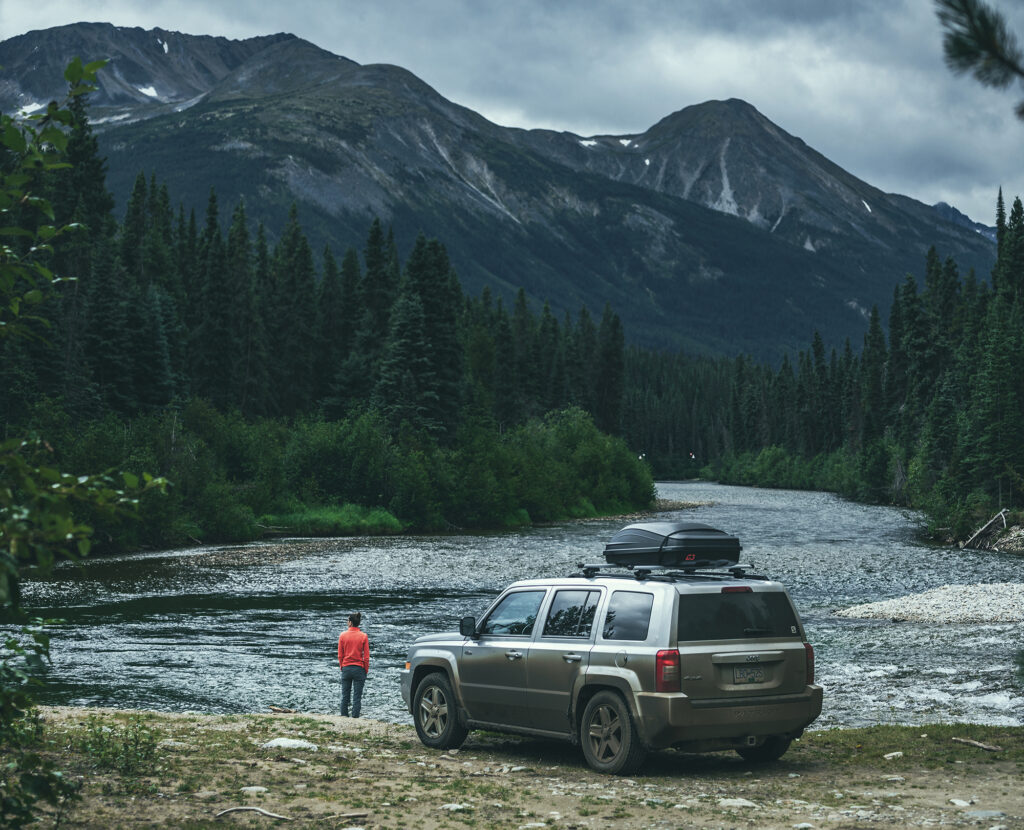
First we stopped at Jade City – which is really more of a trading post, featuring a store off the side of the road that sells all things stones & crystals and specializes in jade, as there is a large resource of it in the area.
We made a quick stop at Good Hope Lake to admire the colour of the water, changing with the movement of the clouds.
Finally we arrived at one of the places I had read about and was on the list of “must see” stops: Boya Lake
Boya lake Provincial Park is evidently a very popular camping destination and that is not surprising. The lake has shades of blue waters that make it look like the tropics. Islands are peppered all around and campsites line the shore, right on the water. The campground was pretty much full, but we weren’t planning on staying there for the night anyways, only spend a few hours and maybe get on the water.
I regretted a bit getting there late – it was already 6pm and we had another 1.5 hour drive to Watson lake. With more time, I would have loved to take the kayaks out on the lake. It was one of the potential paddle stops I had originally planned, but with the weather that morning I didn’t think it would be nice enough to do so, hence the Telegraph Creek detour. But oh well, that’s how it goes, plans don’t always work out and that’s ok. We still got to enjoy the sight of the lake in the sun and really got a sense of how beautiful the water was. Mosquitoes however were still pretty relentless. We had a snack in the day use area then took a quick walk on the trail along the lake before heading out.
We got back on the road and drove to Watson lake to spend the night, stopping only to snap a shot of the Yukon sign as we crossed the provincial/territorial border.
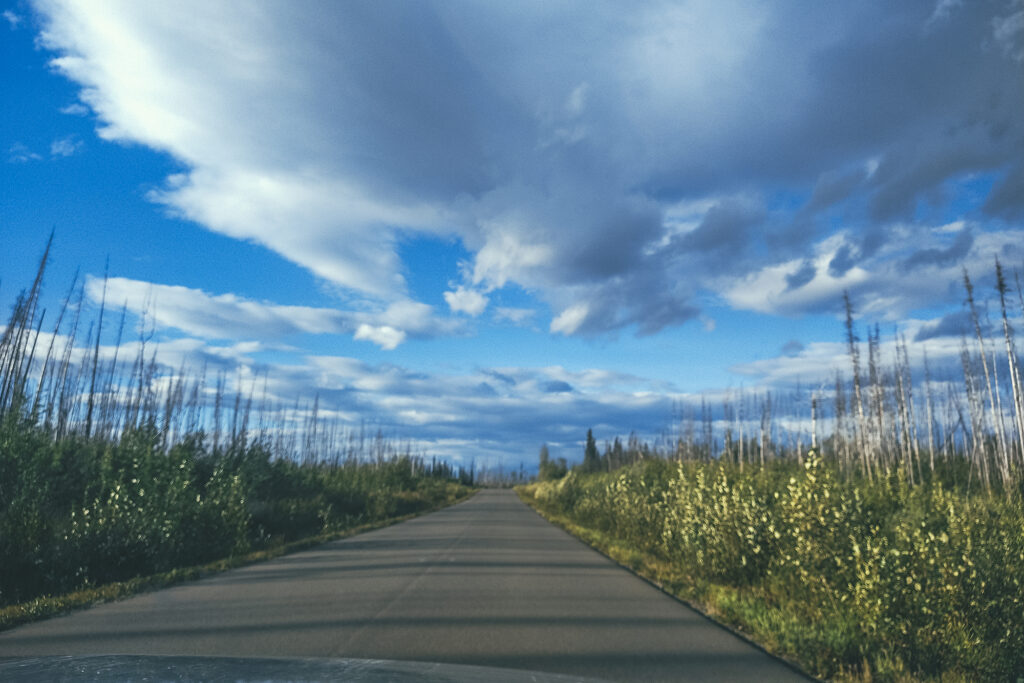
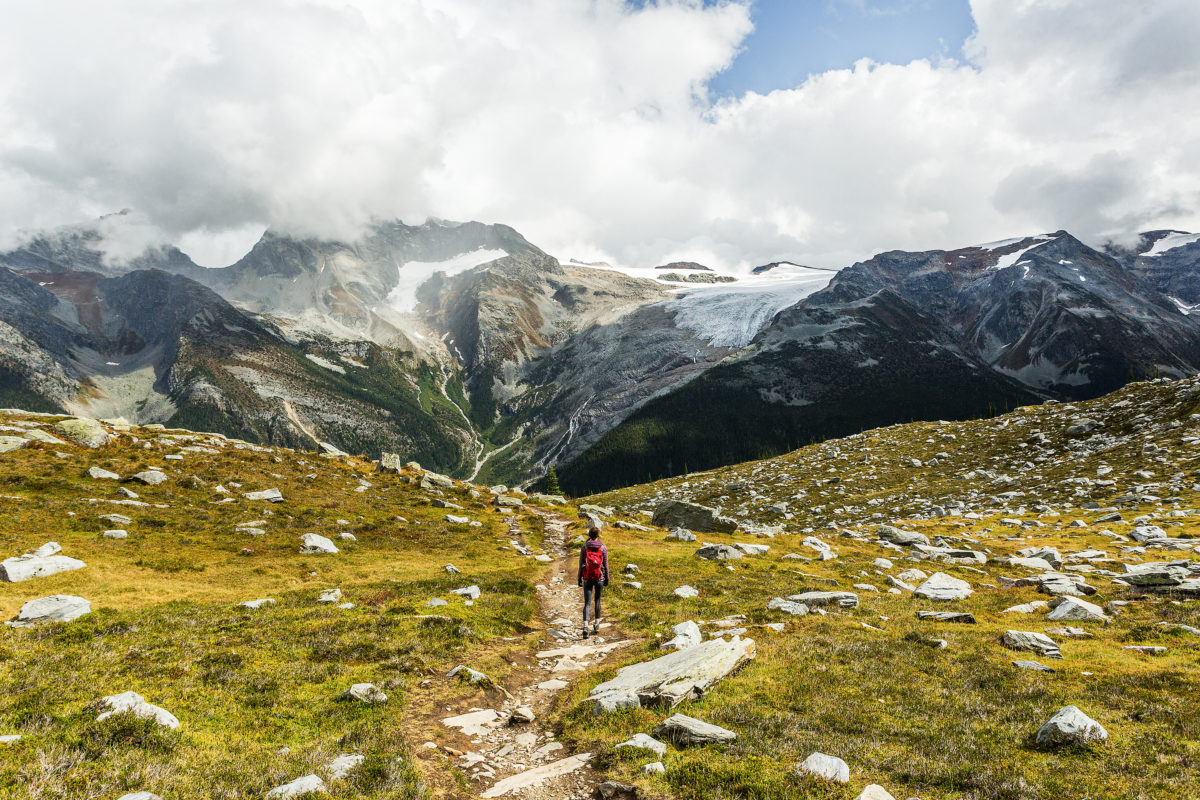
On day 2 of our Canadian Rockies road trip, we headed to the Illecillewaet parking lot, the start of most trailheads in Glacier National Park. The Park is home to black bears and Grizzly, and parties smaller than 4 people are advised not to go on some of the trails that cross the most bear-populated areas.
We decided to hike the Abbott Ridge trail, a short but steep, intermediate-level hike . The first part is mainly single-track switch backs in the forest. 2,6km from the start, we passed Marion Lake, surrounded by dense forest and not very remarkable.
Soon after the lake, at the trail split, we took the shorter but steeper way. The switchbacks continued for a while, but trees slowly gave way to rocky formations, and eventually the trail opened up to a vast alpine meadow with quasi all-around views of the valley and surrounding glaciers. Looking up to the end of the trail, stood the straight rock face of the ridge.
The weather was pretty stable on the way up but we could see black clouds slowly making their way through the valley, and eventually aiming towards where we were. We had lunch at the weather hut then headed back down. It looked like the trail might continue further up, but we weren’t sure how much more, given the straight up wall that stood a few hundred meters from us (after checking online later on, I found out there was indeed a trail that climbed to the top of the ridge).
Still, the view from the meadown was not disappointing, and for a while we watched the clouds dramatically travel through the valley, from Bonner Glacier on the western side, towards the Illecillewaet Neve to the East.
On the way back, we took the longer way down alongside a rocky slope. The two trails reunite about 500 meters before reaching Marion Lake again.
We made it back to the car just as the rain started to pour.
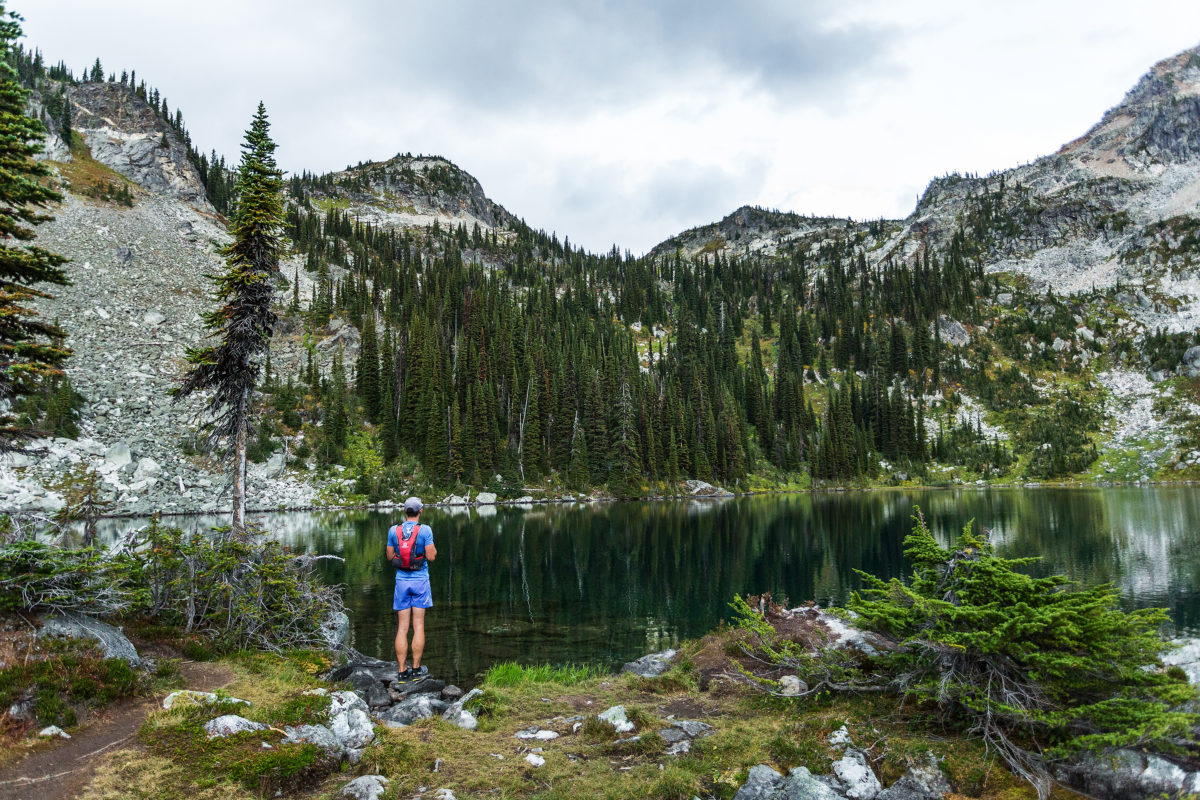
Last September, Brice and I took a short road trip to the Canadian Rockies. Brice had driven through on a couple of occasions, but I had never been East of the Okanagan (on the road anyways). A week break between two jobs turned out to be the perfect occasion to load the car with our camping gear and head to the Rocky Mountains.
Despite our best efforts, we rarely manage to get up and going early – except if we’ve made a commitment to meet with other people. On the first day of our trip, we hit the road around 9am, a pretty late start by adventurer’s standards, but we’ve long ago decided that rather than worry about getting an early start and rushing through the door, we would take the time we needed – the road and everything on it would still be there.
We drove for almost 8 hours on that first day and reached Mount Revelstoke National Park in the late afternoon. We still had a few hours of daylight, enough to go for a 14k return run up to Miller lake.
It was September 13, and already the air was pretty crisp at sunset, but still comfortable enough to run in shorts and t-shirt.
We got to the lake just in time to see the last rays of sunshine hit the base of the mountains around it, and ran back down as dusk settled.
It was dark when we got back to the car, but we were pretty happy to have been able to fit a good shake out run after spending 8 hours in the car.
We had diner in Revelstoke then decided to drive and extra hour east, to camp in Glacier National Park.